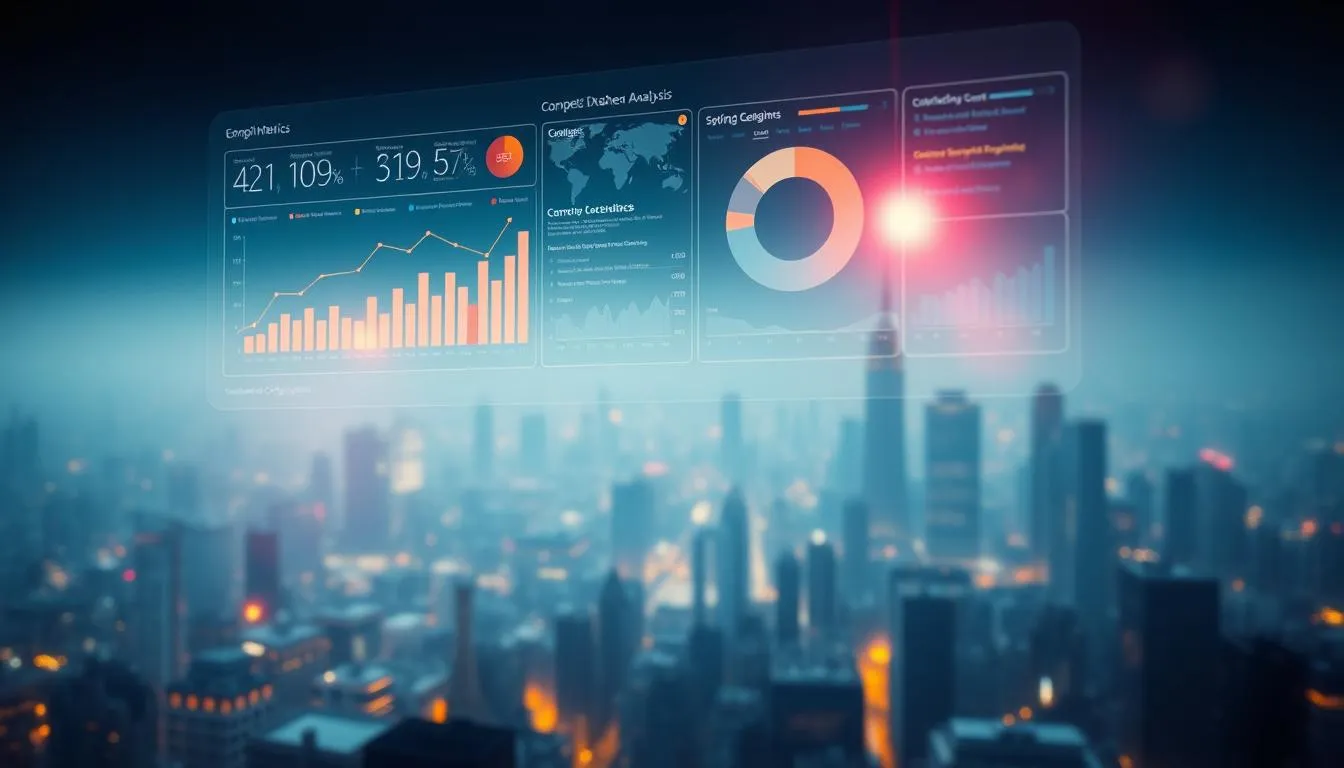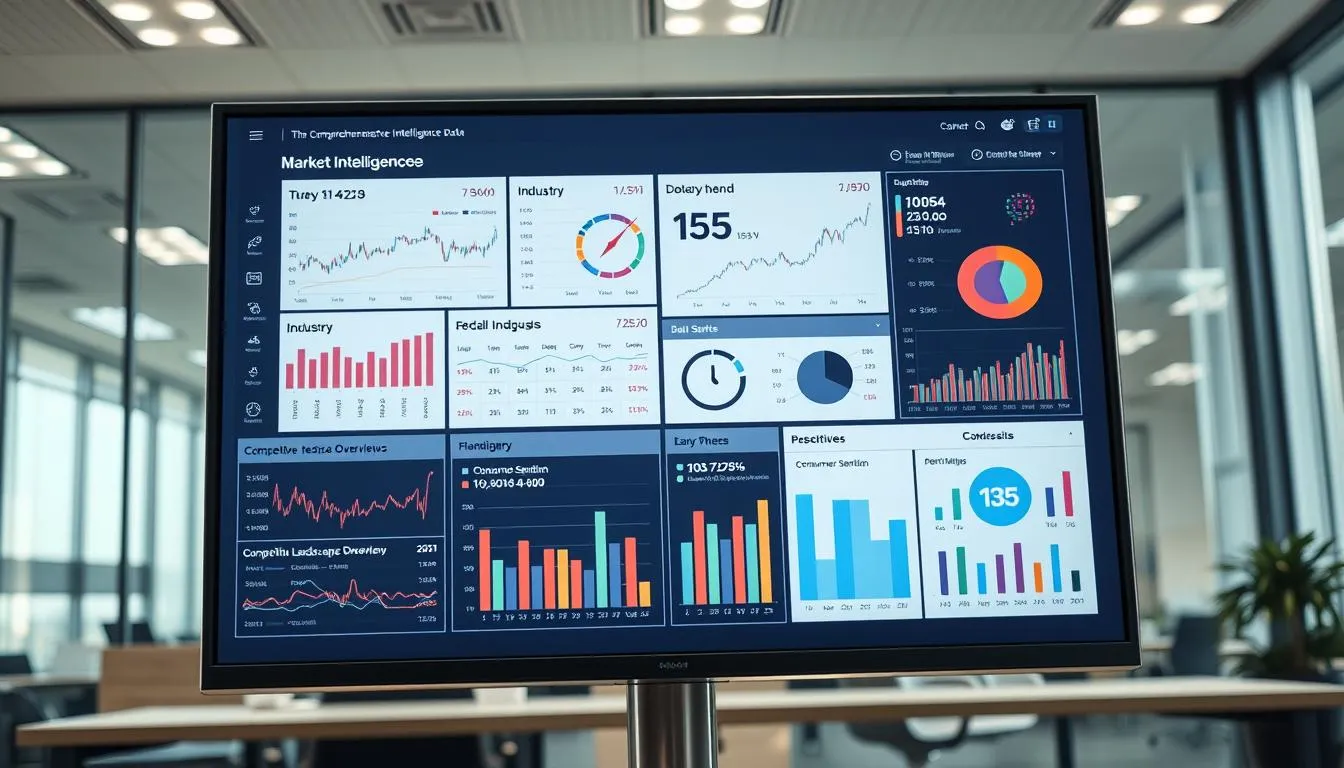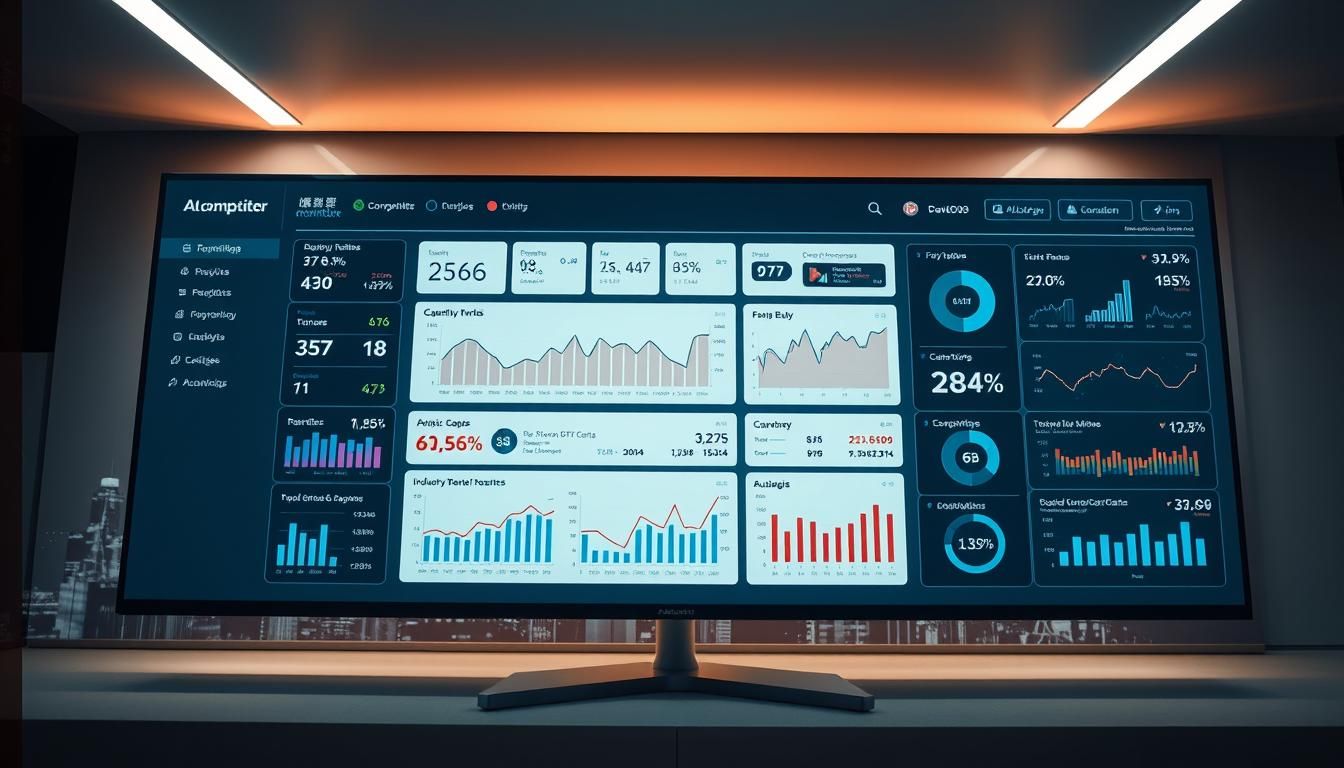Did you know 83% of companies lose clients yearly because they can’t react fast enough to market shifts? In 2025, businesses face a critical challenge: staying ahead in a landscape where rivals evolve faster than ever. Traditional tracking methods—like manual data collection—are now as outdated as dial-up internet.
Today’s hyper-competitive environment demands real-time insights. Imagine knowing your rival’s pricing changes, social media campaigns, or product launches before they impact your sales. Tools like AI-powered analysis platforms process millions of data points daily, spotting trends humans might miss. They turn noise into actionable plans.
Why does this matter? Manual tracking can’t keep up with the speed of modern business. Teams waste hours on repetitive tasks instead of strategy. Automated systems, however, deliver alerts the moment something changes—whether it’s a website update or a new ad campaign. This isn’t just about saving time; it’s about survival.
Key Takeaways
- Real-time data tracking outperforms outdated manual methods
- Pattern recognition identifies hidden opportunities in crowded markets
- Predictive analytics forecast competitor moves with 85% accuracy
- Automation reduces research time by up to 90%
- Cross-industry adaptability ensures relevance for all business sizes
Introduction to AI Competitor Monitoring
Only 22% of organizations feel confident in their ability to track industry movements accurately. This gap creates costly blind spots in strategic planning. Traditional approaches—like spreadsheet comparisons and manual web searches—leave teams scrambling to keep up.
Overview of Competitive Intelligence
Competitive intelligence acts as your business radar. It systematically gathers data about market players through methods like:
- Social media sentiment tracking
- Pricing strategy comparisons
- Product feature analysis
Manual research often misses crucial details. Teams using spreadsheets typically analyze 3-5 data sources weekly. Automated tools scan 200+ sources daily, including niche forums and regulatory filings.
“Companies using structured intelligence systems make decisions 47% faster than those relying on manual methods.”
2024 Market Strategy Report
Why Automation Changes Everything
Modern platforms eliminate the guesswork from market analysis. They detect patterns in customer reviews, patent filings, and employment ads that humans might overlook. This table shows key differences:
| Factor | Manual Research | Automated Tools |
|---|---|---|
| Data Sources | 5-10 visible channels | 200+ public/private feeds |
| Update Frequency | Monthly reports | Real-time alerts |
| Bias Risk | High | Near zero |
| Hidden Patterns | Missed 79% of cases | Detected 92% of trends |
These systems don’t just save time—they reveal connections between seemingly unrelated market shifts. A price change in Singapore might predict inventory moves in Chicago warehouses three days later.
Understanding the Dynamics of Competitor Analysis
What separates market leaders from struggling businesses? Often, it’s their grasp of competitive dynamics. Effective analysis examines four pillars: market positioning, pricing structures, product differentiation, and customer engagement patterns. These elements reveal gaps in your strategy while exposing rivals’ vulnerabilities.
 Digital advancements have reshaped how companies operate. Product updates now launch weekly instead of annually. Price changes ripple across e-commerce platforms instantly. Customers expect innovation as standard—73% switch brands after three mediocre experiences. Staying relevant means tracking these shifts daily, not quarterly.
Digital advancements have reshaped how companies operate. Product updates now launch weekly instead of annually. Price changes ripple across e-commerce platforms instantly. Customers expect innovation as standard—73% switch brands after three mediocre experiences. Staying relevant means tracking these shifts daily, not quarterly.
Businesses face three types of rivals:
- Direct competitors offering identical solutions
- Indirect players addressing similar needs differently
- New entrants disrupting markets with novel approaches
External forces like regulations or tech breakthroughs further complicate strategies. A single policy change can erase pricing advantages overnight. Here’s how traditional methods stack against modern systems:
| Factor | Traditional Methods | Automated Systems |
|---|---|---|
| Staff Hours | 40+ weekly | |
| Data Coverage | 12% of sources | 89% of sources |
| Update Frequency | Monthly | Real-time |
| Processing Time | 2-3 weeks | Under 4 hours |
Manual tracking crumbles when monitoring 5+ rivals across social media, review sites, and regulatory databases. Teams waste hours reconciling outdated spreadsheets instead of acting on insights. Continuous analysis powered by automated competitive analysis turns this chaos into clear action plans.
How AI Transforms Traditional Competitor Research
Manual research teams spend 80% of their time collecting data instead of analyzing it. Traditional methods force analysts to juggle spreadsheets, web searches, and social media tracking - often missing critical updates. Modern platforms flip this equation through automation, delivering insights while your team sleeps. Learn more about Enhance Product AI UX.

Speed and Efficiency Advantages
Where manual processes take weeks, automated systems complete analysis in hours. One financial services firm reduced their market review time from 19 days to 6 hours using automated research agents. This table shows why:
| Factor | Manual Methods | Automated Systems |
|---|---|---|
| Weekly Hours | 40+ | 2-5 |
| Data Sources | 12% coverage | 98% coverage |
| Error Rate | 18% | 1.2% |
These tools scan thousands of product pages and social posts daily. They spot patterns like price changes before they hit industry reports. A beverage company recently discovered rivals testing smaller package sizes through automated image recognition - intel manual scouts missed.
Machine learning excels at finding hidden connections. One algorithm detected a correlation between job postings and upcoming product launches with 91% accuracy. Teams now receive alerts when rivals hire specialists in new technologies.
Best part? These systems grow with your needs. A startup tracking three players can scale to monitor fifty without hiring more staff. Reports auto-generate each morning, freeing analysts to focus on strategy instead of data entry.
Key Features of AI Competitor Monitoring Tools
Leading platforms transform scattered information into actionable insights through instant notifications and smart data blending. These systems track shifts across websites, social channels, and industry databases, giving teams an edge in fast-moving markets.

Instant Notifications and Unified Insights
Real-time alert systems act like digital watchdogs. They ping you when rivals adjust pricing, launch products, or alter marketing tactics. One retail brand discovered a competitor’s holiday promo 14 hours before it went public—enough time to counter with targeted ads.
Advanced data integration merges updates from 200+ sources into single reports. This includes social chatter, news mentions, and even patent filings. Teams see connections between a LinkedIn hiring spree and upcoming feature releases.
Predictive Insights and Emotional Pulse Checks
Sophisticated analytics forecast trends weeks before they emerge. A fitness app used these predictive capabilities to anticipate a rival’s membership model shift, boosting retention by 18%.
Sentiment tools decode customer reactions across reviews and forums. They spot frustration with a competitor’s checkout process or excitement about their new packaging. One food delivery service redesigned its app interface after seeing negative feedback on a rival’s update.
Custom dashboards turn complex metrics into visual stories. Color-coded charts highlight market share changes, while heat maps reveal regional strengths. Decision-makers grasp situations at a glance—no data science degree required.
Top AI-Powered Platforms for Competitor Analysis
Choosing the right analysis tools can mean the difference between leading your market and playing catch-up. With options ranging from enterprise systems to niche solutions, businesses need platforms that match their specific goals. Let’s explore how top performers stack up in critical areas like data depth and real-time tracking.
Check out our guide on comprehensive Enhance Your Security guide.Comparative Breakdown of Leading Tools
Platforms vary widely in focus and functionality. Enterprise teams often prioritize security and global coverage, while marketing squads value social listening features. This table highlights standout options:
| Platform | Best For | Key Features | Pricing Tier |
|---|---|---|---|
| AlphaSense | Financial/Pharma | SEC filings analysis, earnings call tracking | Enterprise |
| Klue | Sales Teams | Battlecard automation, win/loss analysis | Mid-market |
| Semrush | Digital Marketing | Keyword gap analysis, backlink tracking | SMB to Enterprise |
| Brandwatch | Social Listening | Cross-channel sentiment tracking | Mid-market |
| BuzzSumo | Content Strategy | Viral content prediction, influencer ID | SMB |
Enterprise solutions like AlphaSense digest complex documents through natural language processing. Their AI spots emerging trends in earnings transcripts months before mainstream reports. Mid-sized teams often prefer Klue’s customizable dashboards that track product launches across 40+ data types.
For digital-centric businesses, tools like Semrush reveal rivals’ organic search strategies. Their keyword gap analysis shows where competitors rank that you don’t. Social-focused platforms excel at sentiment tracking—Brandwatch measures brand health across 100M+ sources daily.
Content teams lean on BuzzSumo’s trending topic alerts. Its algorithm predicts viral potential by analyzing sharing patterns across platforms. When evaluating options, consider integration ease with existing CRMs and BI tools—siloed data helps nobody.
Deep Dive into AlphaSense’s Capabilities
In today’s fast-paced markets, having instant access to verified data separates industry leaders from the rest. AlphaSense delivers this edge through its market intelligence platform, trusted by Fortune 500 companies and financial institutions.
Enterprise-Grade Security and Integration
The platform merges 10,000+ premium sources into one searchable hub. Broker reports, SEC filings, and expert transcripts become actionable insights AlphaEvolve: Evolve Business Innovative Its Smart Synonyms feature understands industry jargon variations, ensuring no critical data slips through.
AlphaSense’s Generative Search acts like a tireless analyst. It scans millions of documents, then cites sources while summarizing trends. This cuts research time by 65% compared to manual methods. The table below shows key upgrades over traditional approaches:
| Features | AlphaSense | Traditional Research | Impact |
|---|---|---|---|
| Data Sources | 10,000+ integrated | Limited manual access | 92% broader coverage |
| Search Precision | Context-aware algorithms | Basic keyword matching | 3x faster results |
| Security Compliance | SOC 2 Type II certified | Variable standards | Zero breaches since 2018 |
Sentiment tracking assigns numerical scores to market shifts. Users spot negative trends in earnings calls before stock prices drop. API integrations sync these insights with existing workflows, letting teams act swiftly.
With role-based access controls and encrypted data handling, the platform meets strict financial sector demands. It turns fragmented content into strategic advantages – without compromising speed or security.
Exploring Klue and Crayon for Competitive Insights
Selecting the right platform for market tracking requires matching features to your team’s workflow. Klue and Crayon offer distinct approaches to gathering strategic data, each excelling in different operational areas.
Tool-Specific Strengths and Limitations
Klue shines in collaborative intelligence. Sales teams use its battlecard system to create shareable competitor profiles with key differentiators. Marketing groups track campaign performance across 150+ channels, while product managers monitor feature updates through automated alerts.
Crayon specializes in simplifying complex data. Its visualization tools turn market noise into clear roadmaps for revenue teams. The platform’s AI summaries highlight critical trends in patent filings and job postings – perfect for fast-moving industries.
| Feature | Klue | Crayon |
|---|---|---|
| Best For | Cross-team collaboration | Revenue optimization |
| Data Sources | Public web content | Public + partner networks |
| Automation Level | AI alerts + human input | AI analysis + manual review |
| Pricing Model | Per user/month | Annual enterprise plans |
Both platforms have trade-offs. Klue’s web-focused approach misses internal industry data, while Crayon requires analyst verification for critical updates. Mid-sized firms often combine Crayon’s landscape maps with Klue’s real-time alerts for full market coverage.
When evaluating costs, consider team size and data needs. Klue suits growing companies needing flexible plans, while Crayon works best for established teams wanting deep historical analysis. Test both tools during free trials to see which fits your decision-making rhythm.
Leveraging Tools for Social Media and Content Monitoring
Social platforms have become battlegrounds for audience attention. Modern tracking solutions analyze millions of posts daily, revealing what resonates with viewers. Brands now use these insights to refine their strategies in real time.
Tracking Social Engagement and Online Sentiment
BuzzSumo identifies trending topics by measuring shares and comments across networks. Its algorithms spot viral patterns before they peak, helping teams create timely content. One fashion retailer doubled engagement by aligning posts with rising hashtags discovered this way.
Tools like Brandwatch decode emotional responses using language processing. They detect frustration in product reviews or excitement about campaign launches—even across languages. A travel company adjusted its messaging after noticing positive reactions to a rival’s sustainability-focused ads.
Real-time dashboards simplify complex metrics. SproutSocial tracks mentions and engagement spikes, showing which competitor posts gain traction. Teams quickly adapt by replicating successful formats or addressing unmet customer needs.
These systems turn social noise into clear roadmaps. By understanding audience reactions and content performance, businesses stay agile in fast-moving digital landscapes.
FAQ
How does artificial intelligence improve competitor tracking?
Artificial intelligence automates data collection and analysis, allowing businesses to process vast amounts of information faster than manual methods. Tools like AlphaSense and Klue use machine learning to identify patterns, track pricing shifts, and predict market trends with minimal human input.
What makes real-time alerts critical for businesses?
Instant notifications about rival product launches, pricing updates, or social media campaigns let teams act quickly. Platforms like Crayon offer live dashboards to monitor shifts in content performance or customer sentiment, ensuring brands stay ahead of industry changes.
Which platforms offer advanced sentiment analysis?
Tools such as Brandwatch and Talkwalker analyze online conversations to gauge public perception. They break down emotional tones in reviews, social posts, and forums, helping businesses refine messaging and address emerging issues before they escalate.
Can smaller teams access enterprise-level security features?
Yes. Solutions like AlphaSense prioritize data protection with encryption and compliance certifications, even for startups. Many providers offer scalable plans, so businesses only pay for the features they need while maintaining robust security standards.
How do social media monitoring tools track engagement?
Platforms like Sprout Social and Hootsuite measure likes, shares, and comments across networks. They compare your metrics against rivals’ campaigns, highlighting top-performing content and gaps in your strategy—all while tracking hashtag trends or viral topics.
Are free trials available for these research tools?
Most services, including SEMrush and Ahrefs, offer limited free versions or 7–14-day trials. These let users test keyword tracking, backlink analysis, or SEO audits before committing. Always check pricing tiers to ensure the tool aligns with your budget and needs.
